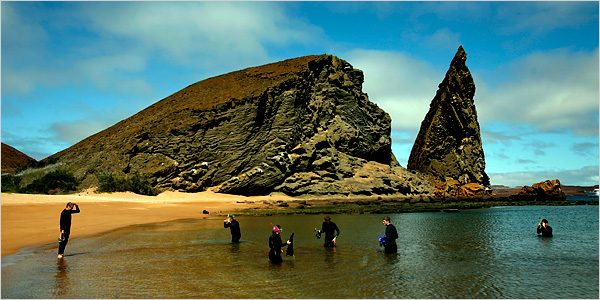Colored Magma
 [Image: ©Michael Nagle for The New York Times].
[Image: ©Michael Nagle for The New York Times].Seeing this photo of the Galapagos Islands, with its strange, almost hand-painted color scheme, like something from an old British postcard, made me wonder if perhaps we might yet discover a way to deep-inject colored dyes into active magma chambers, producing technicolor flows of liquid rock in a million years' time.
Volcanoes will erupt in Chile, forming bright green hillsides, yellow cliffs dotted with blue boulders. A fine pink gravel will wash up and down the steaming beach.
So can we introduce color into underground reservoirs of liquid rock – with the effect that, far after humans have died off, these weird and fantastic displays of dyed geology will arise, poking up beneath eroded soils, revealing themselves in fissures after earthquakes? Colored bulges of bedrock push toward the earth's surface, seeking the sun.
And isn't that exactly what will happen anyway, as mineral belts of industrial waste and plastics compress over time into new stratigraphies? We could pattern future hillsides like Scottish tartans. Like shirts from J. Crew. Like Sol Lewitt: give him a whole magma chamber to play with. Like some vast underground ink-jet cartridge ready to print colored landforms onto the surface of the earth.
Can we dye rock itself?
Unsupervised geological interventions are the future of landscape architecture.
What Ted Turner did for film, we will do for geology: the re-colorization of the planet.
(Photo courtesy of The New York Times).





Comments are moderated.
If it's not spam, it will appear here shortly!
Delightful speculation, but the technical answer is, "probably not." I'd be surprised if we have even industrial dyes that could withstand the temperatures you're talking about, anywhere from 600 C to 1600 C. But more exactly how do we access these chambers in such a way that they do not explode? "The molten rock in such a chamber is under great pressure," after all [wikipedia.]
How about starting with something more simple, like feeding trees with dyed water? Many a grade-school science fair has featured experiments along those lines with celery stalks, but has anyone scaled them up?
Yup...Fender made a line of guitars and basses in the 60's called "Coronado", which had a "Wildwood" finish made by injecting dye into beech trees. The guitars are widely held to suck, unfortunately, but they have an interesting look.
http://bellsouthpwp.net/d/t/dtoole/Wildwood/Wildwood.htm
@ Rombsy --> exactly, you could surely dye the ground with raw copper, iron, calcite, but that stuff is already in the ground anyways...
@G.M. --> I would love to be the entity that is cutting through sedimentary bedrock only to discover a warped grid of iron deposits, all in un-naturally regular order, and to a mathematical geometry that seems almost Cristalin in structure. But these striations, you discover as you dig further continue for many meters an every direction, stay true to their own geometric logic, and none of the surrounding bedrock. You then notice that when the sedimentary bedrock has warped due to tectonic pressures, the iron grid has warped as well. You're looking at New York City in the year 6,000,000 A.D.
The landfill would probably look really interesting after 6 million years of quartz deposits too. You might have a geode, forming from the cavity left from a cabbage or TV tube.
Dear Mr. Manaugh, Your post on nostalgia toned magma reminded me of Jules Vernes' description of slow architecture by under sea creatures (see quote below).
"Madrepores (which must not be mistaken for corals) have a tissue lined with a calcareous crust, and the modifications of its structure have induced M. Milne Edwards, my worthy master, to class them into five sections. The animalculae that the marine polypus secretes live by millions at the bottom of their cells. Their calcareous deposits become rocks, reefs, and large and small islands. Here they form a ring, surrounding a little inland lake, that communicates with the sea by means of gaps. There they make barriers of reefs like those on the coasts of New Caledonia and the various Pomotou islands. In other places, like those at Reunion and at Maurice, they raise fringed reefs, high, straight walls, near which the depth of the ocean is considerable.
Some cable lengths off the shores of the Island of Clermont, I admired the gigantic work accomplished by these microscopical workers. These walls are specially the work of those madrepores known as milleporas, porites, madrepores, and astraeas. These polypi are found particularly in the rough beds of the sea, near the surface; and consequently it is from the upper part that they begin their operations, in which they bury themselves by degrees with the debris of the secretions that support them. Such is, at least, Darwin's theory, who thus explains the formation of the atolls, a superior theory, (to my mind) to that given of the foundation of the madreporical works, summits of mountains or volcanoes, that are submerged some feet below the level of the sea.
I could observe closely these curious walls, for perpendicularly they were more than 300 yards deep, and our electric sheets lighted up this calcareous matter brilliantly. Replying to a question Conseil asked me as to the time these colossal barriers took to be raised, I astonished him much by telling him that learned men reckoned it about the eighth of an inch in a hundred years."Jules Verne, Twenty Thousand Leagues Under The Sea, 1946
Thanks, Meredith - that's a fun image, and a great quotation.
Post a Comment